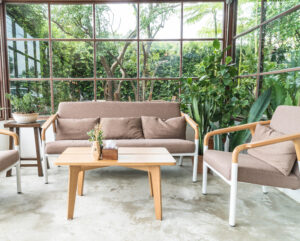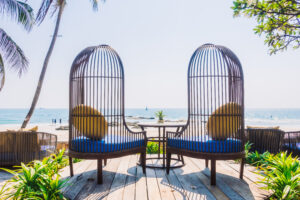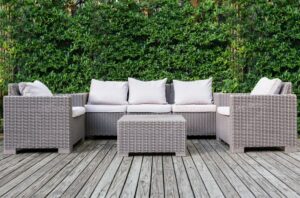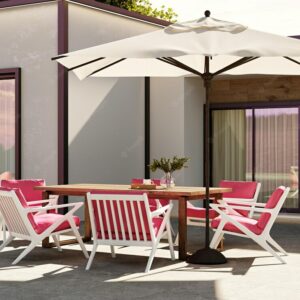How to Clean Outdoor Furniture!
Are you looking for ways to bring your outdoor furniture back to life? Have the elements and exposure take their toll on your patio table, chairs, and sofas? Then you’ll be delighted to know that all is not lost, and you don’t need to invest in a new outdoor suite just yet. There are some useful and effective ways to restore outdoor furniture that can help your warm-weather living and dining spaces look as good as new.
This guide will offer you a comprehensive breakdown of how to clean, treat and protect a range of outdoor furniture, including different items, materials, and conditions. Whether that’s a teak bench for kicking back and reading a book, plastic dining chairs, or a wooden outdoor dining table. Plus, there are also some handy tips on how to keep your outdoor fabrics, such as cushion covers, looking in top condition.

How to clean outdoor wood and wicker furniture
One of the many advantages of wooden furniture is that it can look better with age. Over time, the grain on wood becomes more prominent and it can take on a range of beautiful colors and textures. Of course, this depends on both the type of wood used and the way it is looked after. Wood does require some semi-regular treatments, such as staining or varnishing, to look it’s best. This is especially true if it is going to be left exposed or without a furniture cover.
Excessive exposure to moisture can lead to mildew and mold, which can damage the integral structure of the wood. A combination of moisture and too much sunlight can cause warping and cracking.
However, the good news is that it is possible to clean and restore most kinds of wood – both from dirt and the signs of wear and age. The same applies to wicker furniture (although this can be more susceptible to moisture, so a cover is always recommended).
To remove grime, first you must wipe furniture clear of dirt and debris. Use mild soap and water if needed, but do not use a high-power water jet as this can cause damage to the wood. You can buy specialist wood cleaning products, or you can make your own using a combination of warm water, vinegar, and ammonia. Use a more diluted solution when cleaning wicker than you would for solid wood. Once the furniture has been gently scrubbed using the solution, then make sure it is completely dry before putting any covers back on.
If you have hard wood furniture, then a light sand using a fine paper and a new coat of treatment such as oil, stain or varnish can have your furniture looking as good as new. Again, ensure that all parts of the furniture are dry before putting on the covers.

How to clean metal and plastic outdoor furniture
If your outdoor furniture is made from plastic, aluminum, or iron, then there are problems you may encounter different to those for wood. Of these, rust or oxidation is the most common for metal furniture. Before cleaning any rust, it is necessary to remove as much of the oxidized metal as possible. You can do this by either using a special metal polishing paste or with a homemade solution of white vinegar and water. Try to avoid using alkaline cleaners as these can cause further oxidation.
It’s also important not to use an abrasive cloth as this can cause scratches and abrasions to the surface of the finish. However, you may find that your paint finish is already in need of some repair. If you are going to repaint furniture, then remember to use an anti-rust primer before applying the top coating. This could add years to the lifespan of your outdoor furniture.
For even further protection, a layer of varnish on top of the special metal paint can help to prevent chips, scratches and the first signs of rust. For both wood and metal, an outdoor furniture cover is a good idea to help protect it from exposure to the elements, including rain and extended periods of sunshine. This will help to keep your outdoor lounge looking better for longer.
Plastic furniture is generally easy to clean. Use warm, soapy water and a cloth to remove any dirt or debris and try to ensure that plastic furniture is not left in direct sunlight for too long. However, it is generally very hard wearing.

How to protect fabric and cushion covers
Hard materials like wood and metal can show signs of wear and damage over time, so imagine what might happen to softer materials such as cushion covers and fabrics. Cushions and pillows bring a much-needed softness to your outdoor lounge, but they do need some looking after to be at their best.
Always try to put them away or at least under cover when not in use. This will protect them from rain and sunshine. Try and avoid storing in a damp place as this can lead to mold. It is a good idea to wash them before they get stored and ideally again when you bring them out again at the start of the summer season.
Most cushions and pillows have removable covers that can be washed in the machine, or at the very least given a long soak in soapy water. Dry on the line and ensure that they are 100% free of damp before putting back on the cushion.

How do you clean dirty outdoor fabric?
Most outdoor cushions and pillows have removable covers that can be washed in the machine. Follow the instructions on the label for the most effective cleaning advice. Try and wash at the start and end of the outdoor season to keep them at their best.
How do you remove mildew from outdoor furniture?
It depends on the material and extent of the problem. A scrub with warm soapy water or specialist mildew removable product will help. Try to avoid using a cloth that is too abrasive on metal, buy wooden furniture that could benefit from a light sand before protective coatings are applied.
What is the best way to clean outdoor furniture cushions?
The best way is in the washing machine and most cushions come with removable covers to make this easy. Remember to wash both when bringing out of storage or when putting back over the winter months.







